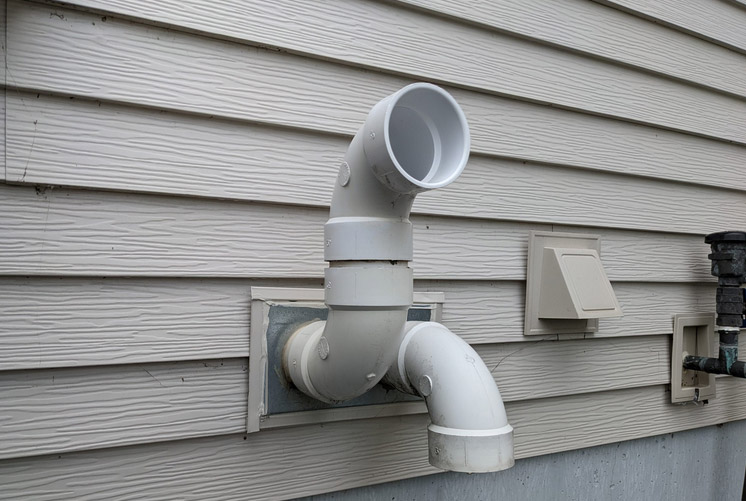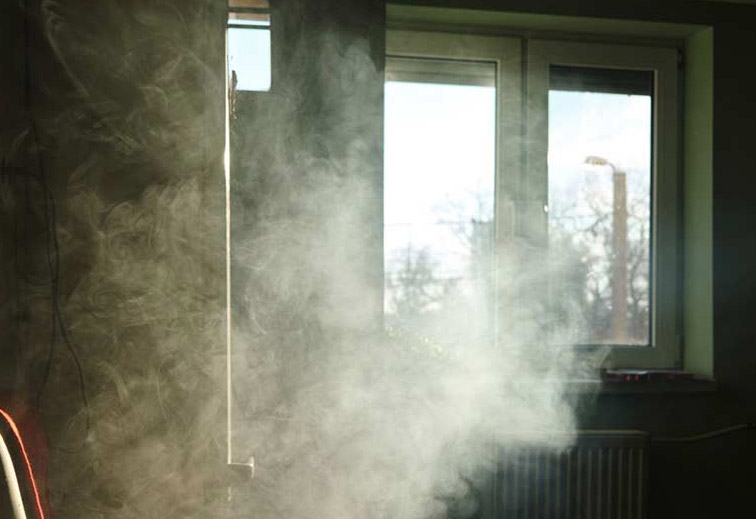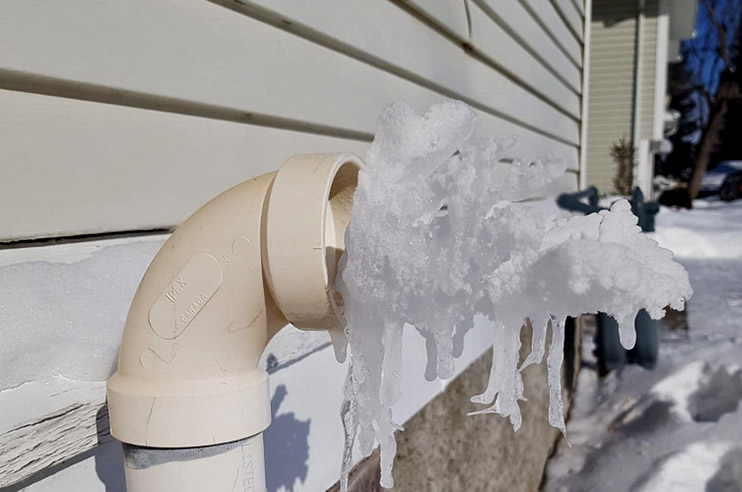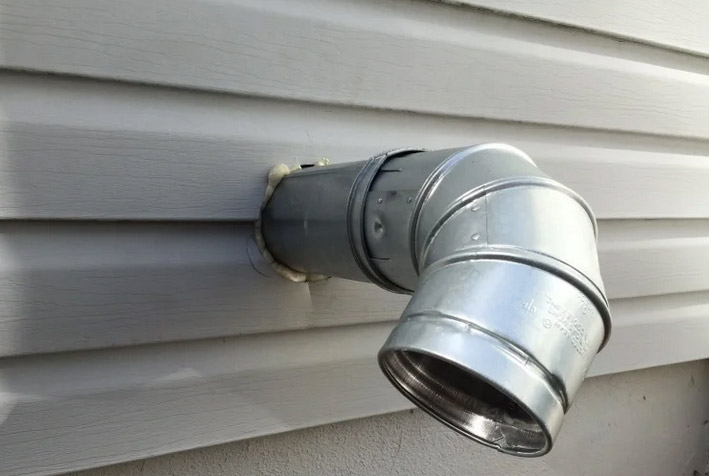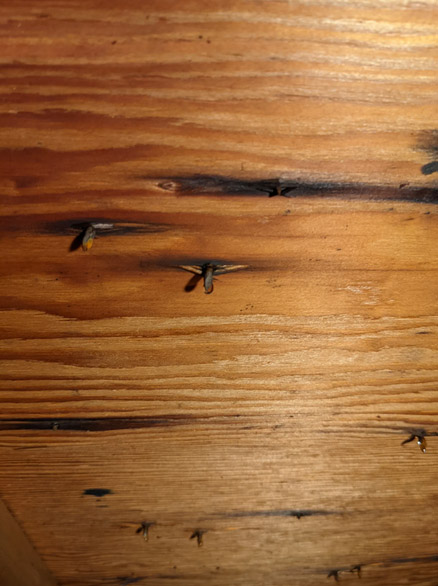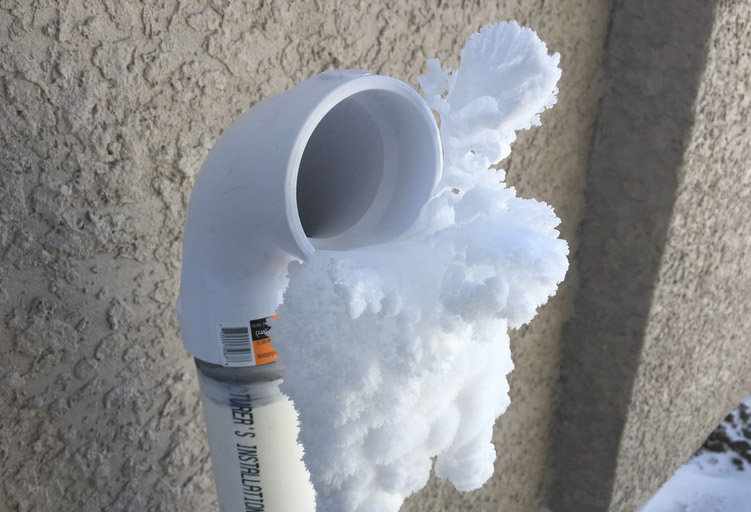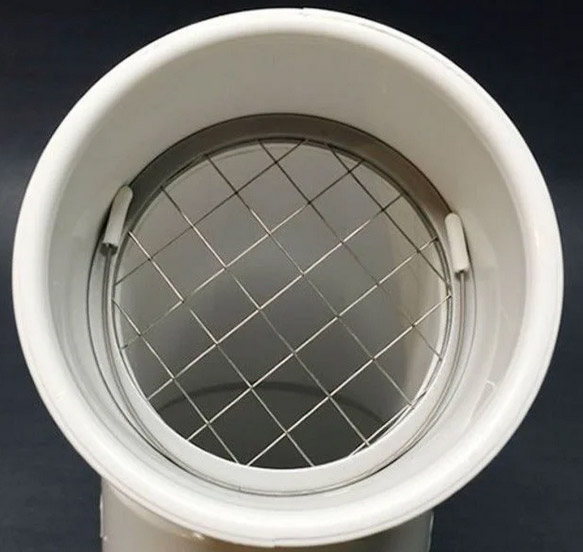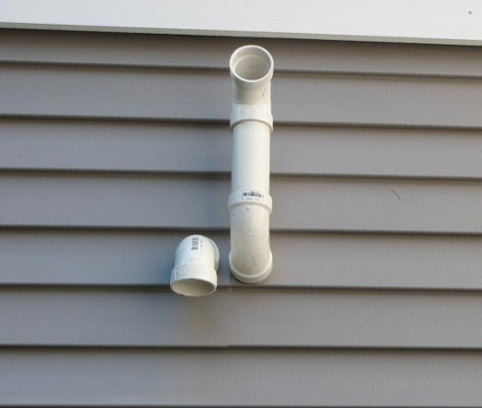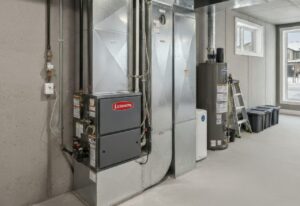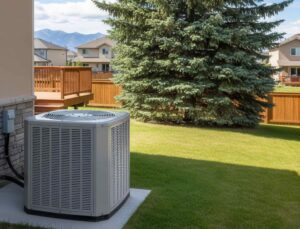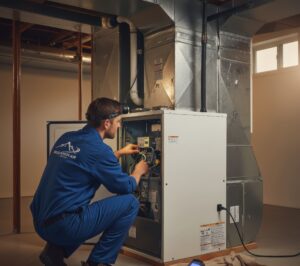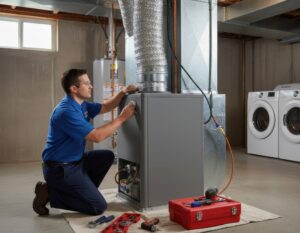All furnaces should be checked at least once a year before the main winter period to ensure efficient and safe performance—including the furnace vent pipe, which plays the critical role of channeling exhaust gases safely out of the home.
An HVAC technician will check all piping during standard furnace maintenance but homeowners should also check vent pipes periodically for problems. Blocked airflow or damage to the exhaust vent (particularly from ice) can cause potentially serious health hazards as well as heating issues requiring emergency furnace repairs.
Here’s what you need to know about checking the furnace vent pipe…
What is a furnace vent pipe?
Standard forced air furnaces have two major pipes:
- An intake pipe channels cool air into the furnace to be heated and circulated around the home.
- A vent pipe (or flue pipe) expels unwanted and potentially harmful gases produced by the combustion process from the home through the chimney.
Depending on the age of your furnace, the harmful combustion gases may exit your home via a PVC vent pipe on the side of the home (usually on an adjacent wall) or run up a flue pipe to a metal or masonry chimney on the roof and be expelled there.
Most new, high-efficiency furnaces in Alberta use a white or grey PVC vent pipe, while older, mid-efficiency furnaces often use a flue/chimney to expel the gases. Wherever your furnace vents, it should be well away from any doors or windows, so that the expelled gases cannot re-enter the home.
It’s worth noting that, traditionally, furnace vent pipes were made of metal, due to the high temperatures of the combustion gases. However, modern, high-efficiency furnaces usually use insulated PVC, CPVC or ABS plastic as vent pipe material.
How does a furnace generate and expel combustion gases?
Combustion gas byproducts include various gases that are produced by furnaces during the normal heating cycle.
A forced air furnace uses natural gas or propane to generate heat in the furnace’s burner. Hot combustion gases heat the walls of the heat exchanger and as the furnace blows air over the hot exterior walls of the heat exchanger, the air is heated and circulated around the home.
When everything is functioning properly, the combustion gases and the circulating air flow through the furnace without ever mixing. The byproducts are safely contained inside the heat exchanger’s chamber before being expelled through the vent pipe to outside the home.
Furnace issues associated with vent pipes
The most serious issue with a damaged, blocked or poorly installed furnace vent pipe is dangerous exhaust gases remaining in the home rather than being expelled outside.
This is known as combustion spillage. If gases build-up due to a lack of checks, serious health consequences can result from the toxic exposure: anything from headaches to death from carbon monoxide poisoning.
Depending on the type of fuel used in your furnace, the toxic by-products that your family could be exposed to if combustion gases are not vented properly include:
- Carbon monoxide (a colourless, odourless, and extremely toxic gas that can be fatal if exposed to for long)
- Polycyclic aromatic hydrocarbons
- Aldehydes
- Unburnt hydrocarbons
- Sulphur oxides
- Nitrogen oxides
- Particulates (e.g. soot)
Combustion spillage can be hard to detect because furnaces are usually located in the basement of Alberta homes and the gases are often invisible and odourless.
Carbon dioxide and water vapour are also produced by furnaces, which can create other problems with indoor air quality.
Backdrafting
Backdrafting occurs when combustion gases from a poorly vented furnace are pulled back into the home rather than being exhausted.
This may happen when insufficient air (oxygen) is supplied to the furnace, hindering the combustion process. Air may be sucked down the flue, preventing exhaust fumes from venting upward and out of the home.
Why do vent pipes fail in Alberta?
The main reason for vent pipes failing in Alberta is blockage from ice during our long winters. This common problem occurs because a great deal of condensation is produced by furnaces during the combustion process, especially high-efficiency furnaces.
This condensation is normally vented out of the pipe system, exiting via the side of the house or the roof. However, if the furnace air isn’t able to leave the exhaust pipe efficiently, the condensation builds and attracts snow, freezing in the sub-zero temperatures.
Over the course of a few weeks, this can build up and form a substantial amount of ice, which blocks the pipe and interrupts or prevents the efficient expulsion of the harmful gases. It also exerts a significant burden on the furnace, potentially damaging components.
Ice formation may be most rapid when the indoor home temperature is set to higher, during the coldest snaps and the furnace works harder, causing yet more ice to build.
This is by far the most common problem with furnace vent pipes in Alberta, where there is a risk of snow or ice forming for much of the year.
Other common vent pipe problems in Alberta apart from ice
Most modern, well-maintained furnaces operate efficiently for years but other potential issues can affect the vent piping. This is mainly due to the constant exposure to high temperatures, corrosive gases, and the extreme elements outside the home, which degrade the piping naturally over time.
Other issues include the following:
- A lack of regular furnace maintenance can mean that problems build up unnoticed until they cause a major issue.
- Wrongly sized vent pipes (too narrow, too short or too long) fail to expel gases adequately, causing ice to build up inside the pipe system in winter.
- Sub-standard installation, such as the vent pipe in the wrong position (it must be at least 12 inches above the ground so that it doesn’t pull in snow).
- Poor insulation of the pipes increases the risk of high condensation and more ice-related problems
- Blockage with debris, such as rocks, bird’s nests, feathers or dead animals, which restrict airflow.
- Corrosion of metal pipes/flues/chimneys due to the condensation produced.
How to check a furnace vent pipe
A simple inspection of the vent pipe from time to time can prevent many furnace issues. But where do you start and what should you be on the lookout for?
It’s best to run vent pipe/chimney inspections at least once before the heating season when the furnace is off. If you’re already using the furnace, switch the power off at the circuit-breaker box before investigating.
To inspect the vent piping of a modern, high-efficiency furnace, check the pipe that runs from the top of the device to outside the home high on an adjacent wall. The exhaust pipe should point upwards while the intake pipe points downwards and should be located at least five feet away. Look for signs of ice, other blockages, water streaks, leaks or rust (if there is metal).
In particular, check for any obstructions lodged inside the pipe. In winter, this is most likely to be ice, but feathers, nesting material or other debris might also be the culprit.
If your furnace vent pipe is on the roof, as with some homes, the vent has a connecting PVC pipe that runs through the attic. Check the attic for signs of excess humidity, such as dark stains along the nails attached to your ceiling, which result from the extra moisture in poorly ventilated spaces (this can harm indoor air quality).
If there are visible signs of wear and tear on any piping you inspect, it may be best to replace it—a relatively small expense considering the safety of your family could be at stake.
How to deal with ice in a furnace vent pipe
If you notice ice around the vent pipe, remove it gently using a broom handle or vent brush without damaging the PVC pipe.
At the same time, it’s a good idea to replace or clean the furnace filter to improve general airflow in the furnace system as part of general maintenance.
If you are still having furnace issues, it’s time to call an HVAC technician for closer inspection and furnace troubleshooting. If any re-piping is required, that’s a job for a qualified professional.
How to clean a furnace vent pipe
If you find blockages, remove the debris carefully, taking care not to damage the piping.
You might be able to carefully use a broomstick to dislodge ash, soot or other debris but don’t attempt this unless you know what you’re doing. A proper vent-cleaning brush is better. Alternatively, a vacuum cleaner with a hose attachment, along with a little pipe- or duct-cleaning solution and a vent-cleaning brush will work. The vacuum hose can suck up dirt and debris, removing it from the vent.
If vegetation is growing within four or five feet of the vent pipe, cut it back or remove it as it could attract debris and other unwanted pests.
It’s generally a good idea to fit a vent screen cap on the exhaust vent if the pipe doesn’t already have one fitted. This can prevent pests and debris from entering the piping when it’s not in use. Simple meshing allows gases to escape while keeping any large debris out.
Remember that all components of furnaces need cleaning from time to time. This is best left to a professional in most cases so that nothing gets damaged.
Most homeowners in Alberta book an annual or bi-annual furnace service during which a licensed HVAC technician performs a thorough check and clean (if necessary) of the vent and intake pipes, as well as all the other essential furnace maintenance tasks.
How often should you check your furnace vent pipe?
If the furnace vent pipe is blocked, combustion gases are not effectively channelled out of the home and this can lead to a variety of serious issues.
Because of this, it’s recommended to check your vent pipe every few weeks during the heating season (especially December through March) if possible. Pay special attention to any buildup of ice or snow during the coldest snaps.
Even if your heating system seems to functioning fine, it’s important to check all major components regularly, including the vent pipe or flue/chimney.
An annual tune-up before the major heating season (in Alberta, that usually means before late September) will include more thorough checks.
Typical signs of vent pipe issues with your furnace
How do you know if your furnace vent pipe is causing problems? Sometimes the signs aren’t very visible.
If your furnace isn’t heating properly or has shut down, you’ll likely call for furnace repairs and an HVAC technician will troubleshoot the issue. A blocked or damaged vent pipe is just one potential cause of the problem.
Other visible signs of wear and tear on the vent pipe, such as rust or water streaks, also indicate a problem., as do unusual furnace noises, such as rattling or buzzing.
Homeowners may also notice vent pipe problems if the indoor air quality dips or strange gas smells are detected. However, carbon monoxide (CO) is colourless and odourless. It’s now mandatory for all residential homes with occupants and fuel-burning devices in Alberta to have carbon monoxide detectors installed.
If anyone in the household is suffering from unexplained and repeated headaches, nausea, dizziness, skin and throat irritations or breathing difficulties, this should be an instant red flag.
Get an immediate check of the heating system. If you notice suspicious odours and suspect a gas leak, evacuate the home immediately and call for assistance.
Sometimes, a furnace can appear to be working efficiently and heating the home without any obvious signs of problems. Vent pipe problem signs can be subtle:
- Hot and muggy air around the heating equipment.
- Excessive condensation or fogging on windows (especially in the morning): this can be a sign that moisture-heavy combustion gas fumes are collecting on the cold glass rather than being expelled outside.
- Rust/corrosion on the furnace: moisture collecting on metal grillwork and the front of the furnace can cause visible corrosion, suggesting that gas fumes may be inside the home.
- Soot buildup around the vents, ductwork or registers: this is a sure sign of a problem with the furnace’s vent pipe.
- Leaking water from the pipe: normally, condensation drains via a pipe and floor drain but it can start to leak if there is a crack or clog in the pipe from wear and tear or corrosion.
- Bubbles in water leaks: if water is leaking from the vent pipe, check if it contains bubbles as this could mean a gas leak.
How to prevent furnace vent pipe issues
Regular inspections of the vent pipe during the heating season can identify problems early and prevent more serious issues—which is far cheaper than repairing furnaces that break down.
At least one thorough annual maintenance before the winter is essential for optimal furnace performance. An HVAC professional should check all components of the furnace thoroughly, clean them, lubricate moving parts, and ensure that everything is functioning safely.
Most importantly, this can prevent combustion spillage and heating problems in midwinter, when Alberta homeowners rely on their furnaces the most.
If in doubt, refer to the Alberta government’s guidelines for venting gas furnaces for further advice on proper venting practices.
If you suspect the furnace vent pipes are improperly installed or have been damaged, it’s essential to seek professional advice.
FAQs
How long should a furnace vent pipe be?
The exhaust pipe should be at least 12 inches long to avoid pulling in snow which can then freeze, block airflow, and lead to heating problems and hazards.
How do you seal around a furnace vent pipe?
Typically, the opening around a furnace flue or chimney can become very hot and therefore, requires special sealing techniques. Lightweight aluminum flashing and special high-temperature (heat-resistant) caulk should be used. Before pushing the insulation back into place, a metal dam should be used to keep it away from the pipe.
The single-wall pipes typically used in older homes must be kept at a safe distance from combustible materials. However, double-wall pipes have an additional outer layer for extra insulation and furnace safety in newer homes.
Safe and efficient furnaces in Calgary
To maintain safety, air quality, energy efficiency, and comfort levels in your home, schedule a year-round furnace tune-up. All of our furnace professionals are SAIT-certified and trained to service any type or brand of furnace in Calgary.Call us at 403-236-4366 or contact us online to book furnace maintenance.
